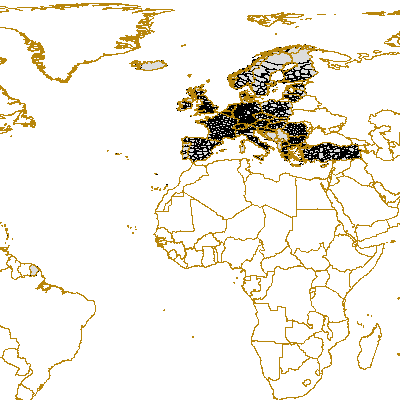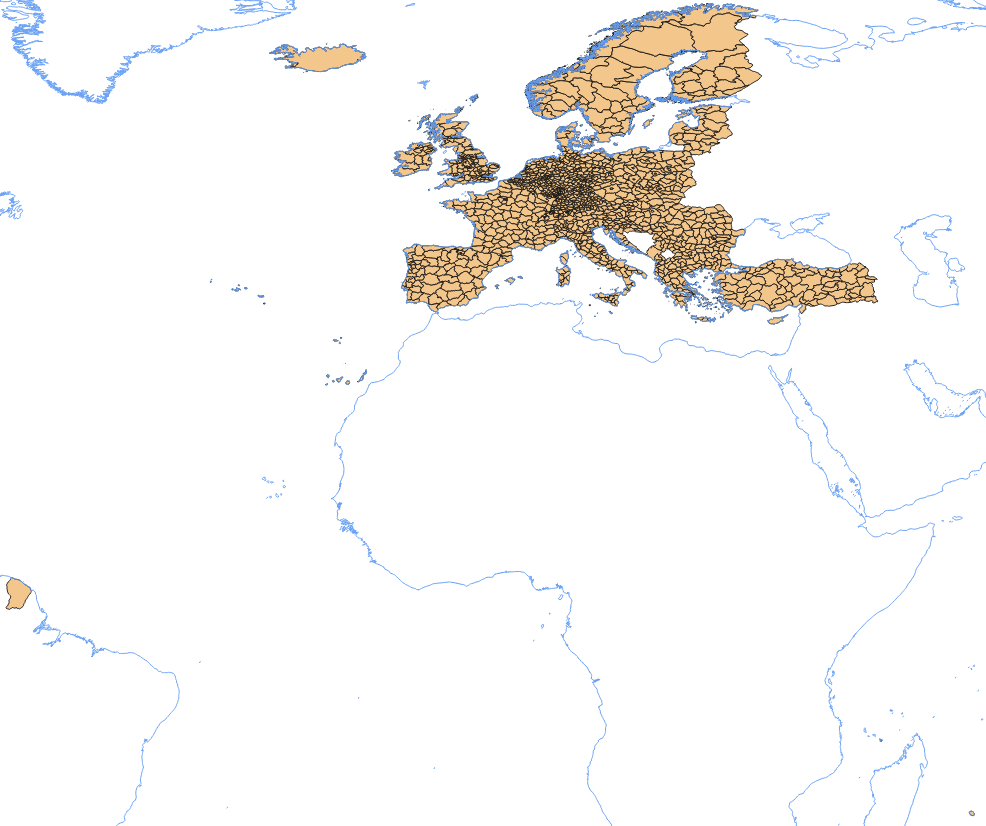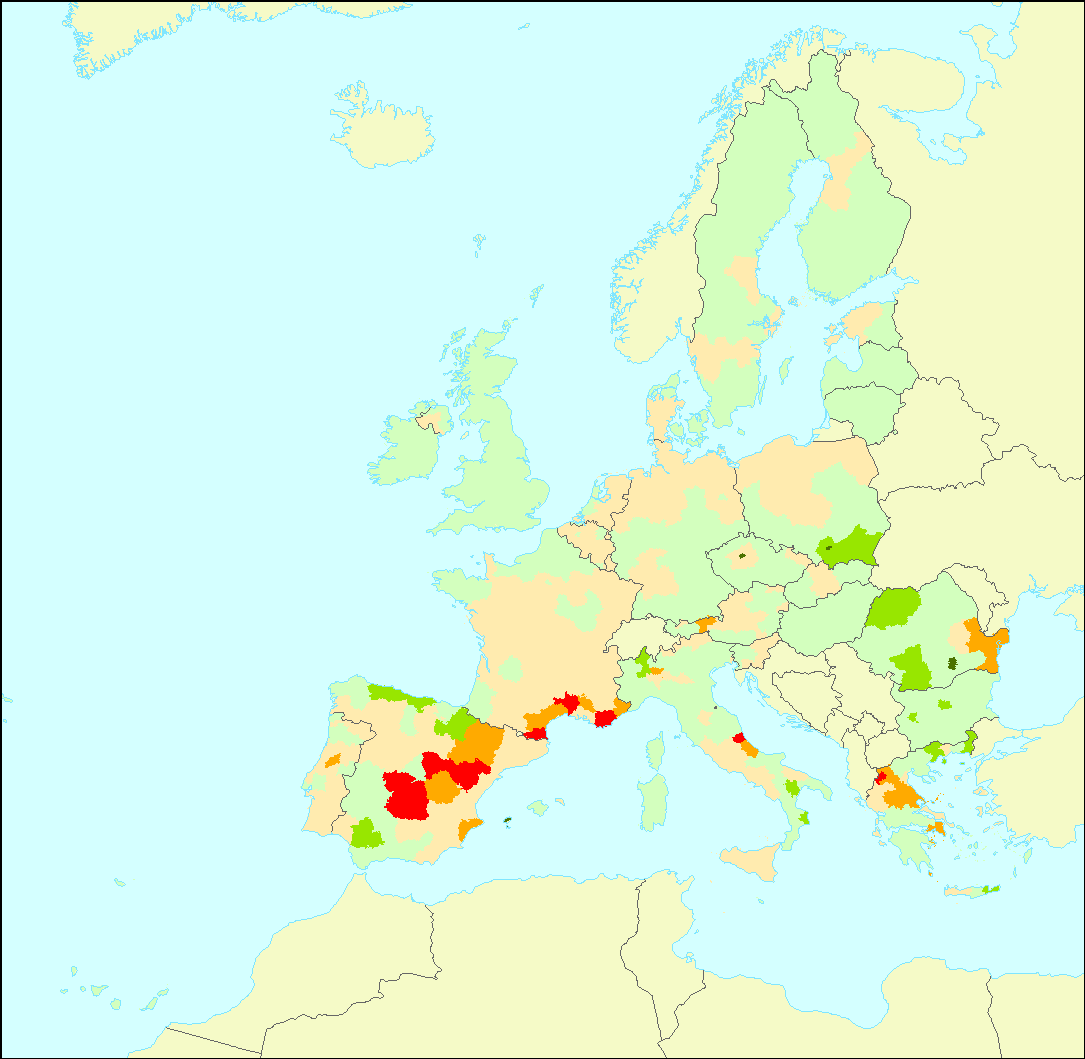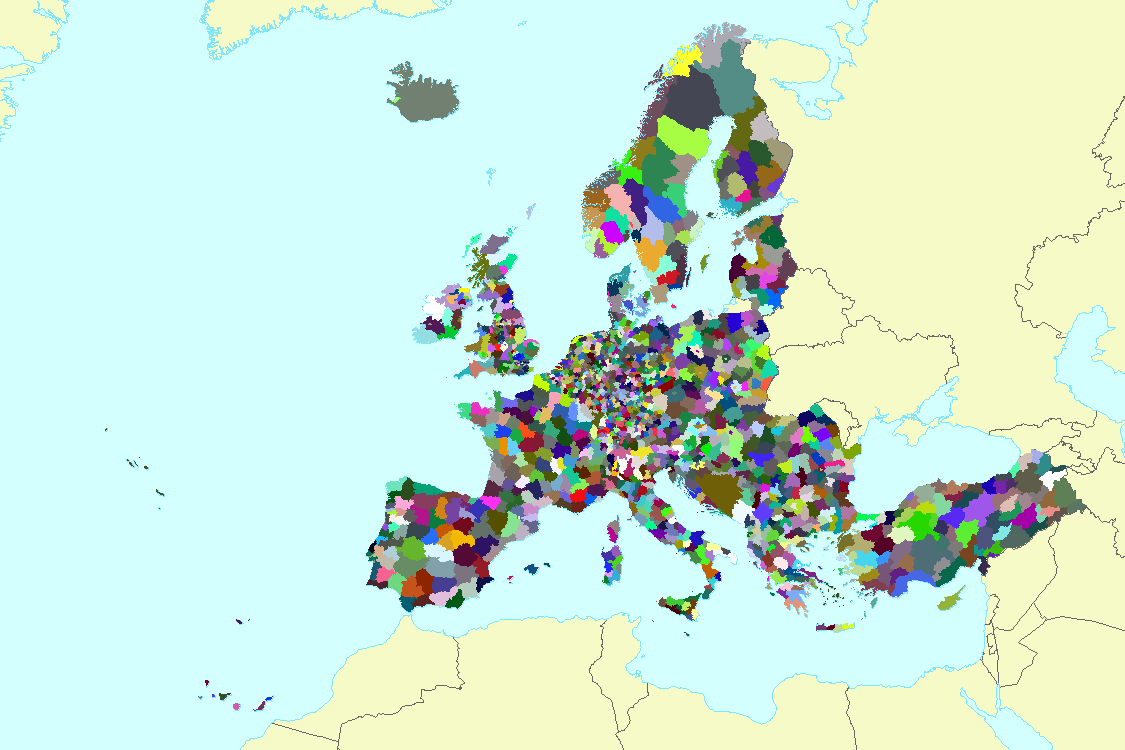Statistical units
Type of resources
Available actions
Topics
INSPIRE themes
Keywords
Contact for the resource
Provided by
Years
Formats
Representation types
Update frequencies
status
Service types
Scale
Resolution
-

The 'GISCO NUTS 2006' dataset represents the NUTS regions by means of region, arc and point topology. The NUTS geographical information is completed by attribute tables and a set of cartographic help lines to better visualise multipart polygonal regions. The NUTS nomenclature is a hierarchical classification of statistical regions defined by Eurostat. The NUTS classification subdivides the EU economic territory into 3 statistical levels. The Regulation (EC) No 1059/2003 of the European Parliament and of the Council on the establishment of a common classification of territorial units for statistics (NUTS) was enforced the 11 July 2003. This regulation provided the NUTS classification with a legal background. Since then, 12 new countries joined the European Union. The NUTS regulation was officially enforced in these 12 countries the day of their accession to the EU. A non official NUTS-like classification has been defined for the EFTA countries, Croatia and Turkey. For further information about the NUTS classification please check the RAMON Eurostat site at http://ec.europa.eu/comm/eurostat/ramon/nuts/home_regions_en.html At present, six scale ranges (100K, 1M, 3M, 10M and 20M, 60M) are maintained in the GISCO geodatabase. The polygon and boundary classes delineate the regions while the points provide a label for each region. Associated tables contain basic information such as the region's name. This feature class represents the polygon geometry of the 1:100.000 scale level of the NUTS regions. This shapefile was modified by the ETC-LUSI with the purpose of including this dataset into the LEAC System.
-
The contents are data from the data set "Danmarks Administrative Geografiske Inddelinger (DAGI)", transformed to the INSPIRE Statistical Units Vector GML application schema v4.0.
-

This data set represents the regions for level 1, 2 and 3 of the Nomenclature of Territorial Units for Statistics (NUTS) for 2010. The NUTS nomenclature is a hierarchical classification of statistical regions and subdivides the EU economic territory into regions of three different levels (NUTS 1, 2 and 3, respectively, moving from larger to smaller territorial units). NUTS 1 is the most aggregated level. The NUTS classification has been officially established through Regulation (EC) No 1059/2003 of the European Parliament and of the Council and amendments. A non official NUTS-like classification has been defined for the EFTA countries and candidate countries. An introduction to the NUTS classification is available here: http://epp.eurostat.ec.europa.eu/portal/page/portal/nuts_nomenclature/introduction This data set has been created mainly from the EuroBoundary Map v 5.0 (Eurogeographics), geographic information from TurkStat for Turkey, the Global Administrative Unit Layer from FAO (UN) for Macedonia and a list of communes per statistical region provided by the countries. Six scale ranges (100K, 1M, 3M, 10M and 20M, 60M) are available. The public data set (1M - 60M) is available for download at http://epp.eurostat.ec.europa.eu/portal/page/portal/gisco_Geographical_information_maps/popups/references/administrative_units_statistical_units_1 The full data set (100K - 60M) is available to EEA due to EEA having a valid EBM v5.0 licence. Coverage is the economical territory of the EU, EFTA countries and candidate countries as in 2010. These metadata are derived from the original metadata records available at Inspire@EC.
-

The dataset represents a pressure trend indicator as measure of intensification of agroecosystems. The trend indicator is the share of grassland area affected by internal Land Cover flows between CORINE 2006 and 2012, presented at NUTS3 level. Those changes were used to identify the internal flows related to more intense use, mainly linked to the increase in resource and machinery use. The internal flows related to intensification were defined based on an expert consultation done in the context of the ETC/ULS actions.
-

This dataset represents the regions for levels 1, 2 and 3 of the Nomenclature of Territorial Units for Statistics (NUTS) for 2016. The NUTS nomenclature is a hierarchical classification of statistical regions and subdivides the EU economic territory into regions of four different levels (NUTS , 1, 2 and 3, moving respectively from larger to smaller territorial units). NUTS 1 is the most aggregated level. An additional Country level (NUTS 0) is also available for countries where the the nation at statistical level does not coincide with the administrative boundaries. For example Mt Athos in Greece and Mellum and Minsener Ogg in Germany. The NUTS classification has been officially established through Regulation (EC) No 2016/2066 of the European Parliament and of the Council and its amendments. A non-official NUTS-like classification has been defined for the EFTA countries and candidate countries. An introduction to the NUTS classification is available here: http://ec.europa.eu/eurostat/web/nuts/overview. This dataset has been created mainly from the EuroBoundary Map v 12 (Eurogeographics) and geographic information from TurkStat for Turkey. The public dataset is available at 1M, 3M, 10M, 20M, 60M, while the full dataset at 100K is restricted. Coverage is the economic territory of the EU, EFTA countries and candidate countries as in 2016. This metadata only refers to a pre-release version of the full nuts 2016 dataset at 100k (it does not contain Albanian boundaries) and shall only be used internally by the EEA following the conditions stated in the document "GISCO-LicenseconditionsforEGdatasets.pdf" provided with the dataset. This metadata has been slightly adapted from the original metadata file provided by Eurostat (European Commission) and is to be used only for internal EEA purposes. For reference, the original metadata file provided by ESTAT (NUTS_2016.xml) is also available for download together with the dataset. The public datasets, at smaller scales, are available on http://ec.europa.eu/eurostat/web/gisco/geodata/reference-data/administrative-units-statistical-units/nuts#nuts16.
-

This dataset represents the regions for levels 1, 2 and 3 of the Nomenclature of Territorial Units for Statistics (NUTS) for 2013. The NUTS nomenclature is a hierarchical classification of statistical regions and subdivides the EU economic territory into regions of three different levels (NUTS 1, 2 and 3, moving respectively from larger to smaller territorial units). NUTS 1 is the most aggregated level. The NUTS classification has been officially established through Regulation (EC) No 1059/2003 of the European Parliament and of the Council and its amendments. A non-official NUTS-like classification has been defined for the EFTA countries and candidate countries. An introduction to the NUTS classification is available here: http://ec.europa.eu/eurostat/web/nuts/overview. This dataset has been created mainly from the EuroBoundary Map v 8.x (Eurogeographics) and geographic information from TurkStat for Turkey. The public dataset is available at 1M, 3M, 10M, 20M, 60M, while the full dataset at 100K is restricted. Coverage is the economic territory of the EU, EFTA countries and candidate countries as in 2013. This metadata only refers to the full dataset at 100k and shall only be used internally by the EEA following the conditions stated in the document "GISCO-LicenseconditionsforEGdatasets.pdf" provided with the dataset. This metadata has been slightly adapted from the original metadata file provided by Eurostat (European Commission) and is to be used only for internal EEA purposes. For reference, the original metadata file provided by ESTAT (NUTS_2013.xml) is also available for download together with the dataset. The public datasets, at smaller scales, are available on http://ec.europa.eu/eurostat/web/gisco/geodata/reference-data/administrative-units-statistical-units/nuts#nuts13.
-

The dataset represents a pressure trend indicator as measure of intensification of agroecosystems. The trend indicator is the share of cropland area affected by internal Land Cover flows between CORINE 2006 and 2012, presented at NUTS3 level. Those changes were used to identify the internal flows related to more intense use, mainly linked to the increase in resource and machinery use. The internal flows related to intensification were defined based on an expert consultation done in the context of the ETC/ULS actions.
-

The dataset represents a measure of intensification trend of agroecosystems. Nutrient input is a specific measure related to the intensification processes in the management of grassland ecosystems. The average change rate of nutrient input between 2005 and 2010 is used to show these tendencies in the NUTS regions (NUTS3 and NUTS2 for Germany). The data comes from the EEA draft nutrient accounts, developed by EEA and ETC/ULS, and is based on spatial reference data on crop and livestock distribution, yield and livestock statistics, and official conversion factors.
-

The dataset represents the administrative boundaries of the 39 EEA countries at various aggregation level: Country (NUTS0), NUTS1, NUTS2, and NUTS3 regions. The dataset is created in raster format with a spatial resolution of 100m grid size. Spatial extent of the dataset is adjusted to the latest Corine Land Cover product [Corine Land Cover 2012 (raster 100m) - version 18, Sep. 2016]. Administrative boundaries were derived from the EUROSTAT GISCO dataset [European Commission, Eurostat (ESTAT), GISCO -Nomenclature of Territorial Units for Statistics 2016 (NUTS), Mar. 2018], EuroGeographics product [EuroBoundaryMap (full European coverage) - version 12, Jan. 2018], and coastal areas were derived from the Economic Exclusive Zone dataset [version 10.0 available in marineregions.org]. This dataset is created as a reference layer for performing spatial analysis and calculating statistics at country level for the European territory as needed by accounting activities such as Land and Ecosystem Accounting (LEAC).
-

The dataset represents a measure of intensification trend of agroecosystems. Nutrient input is a specific measure related to the intensification processes in the management of cropland ecosystems. The average change rate of nutrient input between 2005 and 2010 is used to show these tendencies in the NUTS regions (NUTS3 and NUTS2 for Germany). The data comes from the EEA draft nutrient accounts, developed by EEA and ETC/ULS, and is based on spatial reference data on crop and livestock distribution, yield and livestock statistics, and official conversion factors.
 RUC Geo-Data catalogue
RUC Geo-Data catalogue